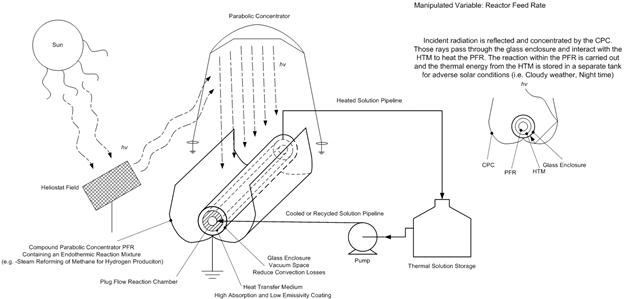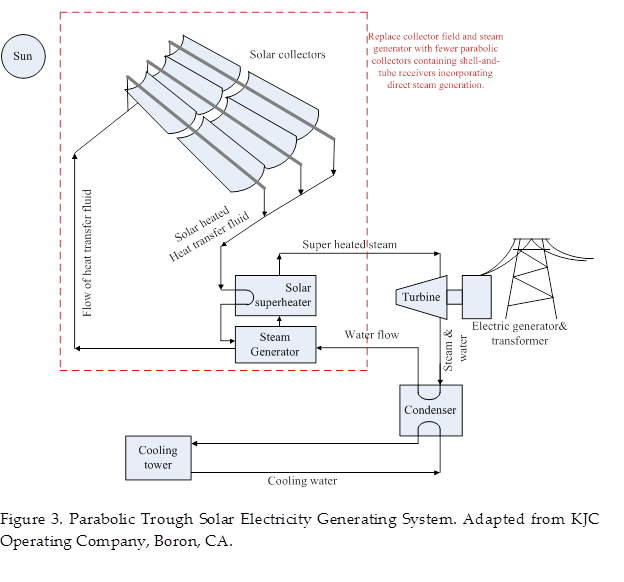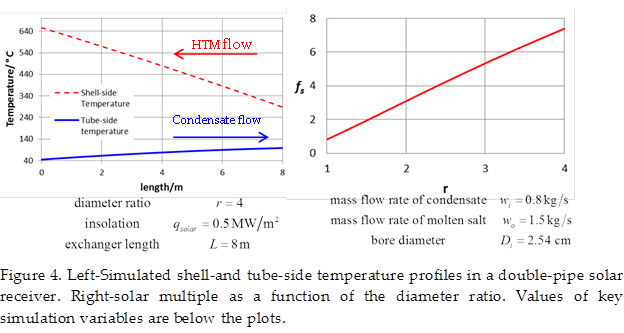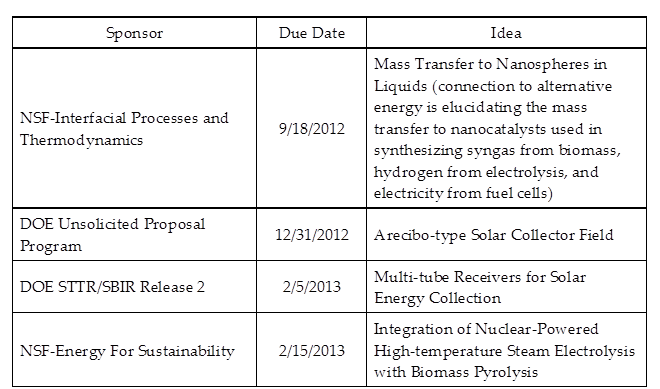57th Annual Report on Research 2012 Under Sponsorship of the ACS Petroleum Research Fund
Reports: ND1049638-ND10: Pyroelectrically-Mediated Reduction-Oxidation Reactions
Theodore F. Wiesner, PhD, PE, Texas Tech University
-Long-Term Goal
"Making Solar Energy Economical" is one of the Grand Challenges posed by the National Academy of Engineering. As we indicated in our second progress report, we have adjusted our research direction to solving two major problems impeding the adoption of solar energy for the production of chemical fuels and electric power. These problems are 1) the variable availability of solar energy, the so-called intermittency problem, and 2) the high capital cost associated with the solar collector field.
-Scientific Objective
Our approach is to design and optimize a multi-tube solar receiver. The multi-tube solar receiver combines multiple pipe bores with a single receiver surface. In the same fashion as current heat collection elements (HCE), the outer surface of the receiver absorbs radiation while a heat transfer medium such as molten salt circulates within the shell. However, the shell also contains a tube, within which the collected heat can directly generate steam (DSG) or drive an endothermic reaction such as a water-splitting thermochemical cycle (WSTC), producing hydrogen. We envision the evolution of the technology as illustrated in Figure 1.
One stores the solar energy in the form of heat in molten salt. Excess hot salt is stored in a thermal storage tank to buffer the reactor from changes in insolation. The apparatus is sized to accumulate sufficient energy in the heat transfer medium during periods of insolation to maintain the steam generation or the reaction when solar radiation is reduced or unavailable (Figure 2). The advantages of this configuration are: 1) The diurnal fluctuations in insolation to an energy production facility are smoothed with sufficient salt storage capacity. 2) In the case of steam-electricity generation, the separate power block is eliminated.
Figure 2- Solar receiver-reactor with integrated energy collection and storage.
-Progress to Date
-Solar Thermochemical Hydrogen Production
In February 2012, we published our first paper on the project, in the International Journal of Hydrogen Energy, presenting our results on the production of hydrogen by Cu-Cl cycle. Our simulations indicate that the addition of intermediate storage can sustain steady 100% conversion during 24/7 operation with a reasonable plant layout. The detailed results are available in the archival publication.
-Shell-and Tube Direct Steam Generation by Solar Power
Presently, parabolic trough solar energy generation systems (SEGS) feature directly irradiated tubular heat collection elements (HCE) that transfer enthalpy to a heat transfer medium (HTM). An SEGS based upon a parabolic trough collector field is depicted in Figure 3. The collector field consists of many parabolic troughs and receivers, and the hot HTM is collected in a manifold. Steam is generated by energy exchange with the HTM in a power block separate from the collector field. As indicated in Figure 3, we envision replacing the collector field and steam generator with a smaller number of parabolic reflectors and shell-and-tube receivers incorporating direct steam generation (STDSG).
A preliminary mathematical model demonstrates the potential of the shell-and-tube direct steam generator. (Figure 4. Note: In the preliminary model, we have simulated heating the condensate only to saturation temperature due to the complexity of modeling vaporization.) In the left panel, one sees that the temperature of both the annular and the bore fluids increase simultaneously. Therefore, one can heat the bore fluid while on-sun, and accumulate energy in the annular HTM for use off-sun. In the right panel, the solar multiple monotonically increases as the diameter ratio r= Do/Di increases. The value of the solar multiple fs should be approximately three in order to sustain 24/7 steady state power production without backup from another fuel source. fs= 3 for r=2, suggesting that reasonable geometries are attainable with an STDSG.
We are presently extending the preliminary double-pipe model to a shell-and-multi-tube model. In the latter, we are incorporating tube-side vaporization, unsteady-state behavior, and the more intricate shell-and-tube geometry (Figure 5).
We are presenting this research in a platform talk at the 2012 AIChE Annual Meeting, in the session entitled "Concentrated Solar for Power Generation and Chemical Processing I"
-Impact of the Research on the Career of the Principal Investigator and His Students
The PRF grant has allowed me to make the successful transition to alternative energy research after fifteen years of conducting research in biomedical engineering.
My PRF grant is supporting one doctoral student, Ms. Rong Xu, who is an outstanding researcher with a tremendous work ethic. Ms. Xu is the first author on the paper already published on this project. Rong is also the winner of 2nd place in the 11th Annual Graduate Student Poster Competition, conducted by the Texas Tech University Graduate School in April 2012. Lastly, Rong is presenting the research on the solar thermochemical production of hydrogen in a platform talk at the 2012 AIChE Annual Meeting, in the session entitled" Advances In Thermochemical Hydrogen Production".
Four undergraduate research assistants have assisted Ms. Xu for course credit.
-Future Plans Arising from PRF-Supported Research
Support of my research program by ACS-PRF has spawned a whole host of ideas in the area of alternative energy. Below is my schedule of proposal submittals in alternative energy in the near term.
















